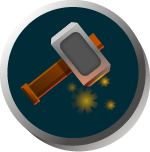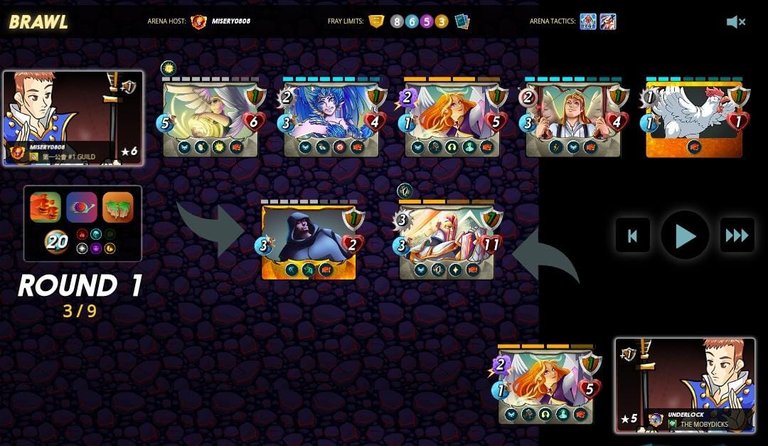The Repair Ability Problem

Translated by ChatGPT.
Another week of Brawls, and this time it was even tougher. Unlike last week, where I managed a 7/1 record, this time I at least stayed positive with 5 wins and 4 losses. During one of these battles in Splinterlands, I observed that the Repair ability has a rather "problematic" aspect that hinders its optimization.
I put "problematic" in quotes because the developers may have deliberately designed it this way for balance reasons, or there might be criteria defining the target of Repair that I am not aware of. The fact is, this ability can provide interesting survivability for your team, and depending on the situation, it can make your card "immortal", preventing the opponent from eliminating it because the attack never reaches its health.

However, if someone is focusing on your support card with this ability and your frontline, the chosen card to receive the benefits of Repair may not be the best option. In my view, self-protection should be an additional mechanism of this ability so that, in dangerous situations, the focus of the effect would be on the card itself. It might sound confusing, but let's visualize it in practice.

(Please excuse the image quality; I'm traveling and using my phone to create this post.)
In this match, the opponent had two cards focusing on Uriel the Purifier, and one attacking Adelade Brightwing. In this specific situation, I would lose anyway, but let's imagine that instead of Pelacor Arbalest, there was a card with only 1 damage. Adding this damage to the 2 from the enemy Adelade, they would cause 3 damage per round, which would be completely healed by Uriel's Heal.
Meanwhile, in the backline, the Harpy would be focusing its attacks on my Adelade. The problem is that in this situation, the focus of Repair is on Uriel, so regardless of whether he needs that armor regeneration, Adelade will target the Repair on him and eventually be eliminated, losing the support ability and the possibility of using Resurrect. This is a significant drawback of this ability that needs to be taken into consideration. If there were a self-preservation mechanism, Adelade could regenerate her own armor and "trap" the Harpy's attacks on her, buying enough time for Uriel to eliminate the opponent's cards.

Now, I ask those who know exactly how the Repair ability works, is the information available somewhere about the rules for determining the focus of who will receive the ability's effect?
This information is valuable and can assist in the development of strategies focused on this ability, so I greatly appreciate it if someone can share it with us in the comments!
Thank you so much to everyone who read this far, I hope you enjoyed it. If you like my content, I ask you to send your vote on the post and follow my profile so you can read future posts.




Mais uma semana de Brawls e dessa vez foi ainda mais difícil. Diferente da semana passada em que eu consegui 7/1, desta vez eu consegui ao menos permanecer positivo atingindo 5 vitórias e 4 derrotas. Durante uma dessas batalhas no Splinterlands eu observei que a habilidade Repair possui um "problema" muito ruim que atrapalha a otimização do seu uso.
Chamo de problema entre áspas pois os desenvolvedores podem ter simplesmente escolhido que ela funcionasse assim para questões de equilíbrio, ou então existem critérios que definem o alvo do Repair que eu ainda não conheça. Fato é que essa habilidade pode fornecer uma sobrevida muito interessante para o seu time e dependendo da situação será possível ficar "imortal", fazendo com que o oponente não consiga eliminar sua carta pois o ataque nunca atingirá a vida.

Porém se houver alguém focando sua carta de suporte que possui essa habilidade e a sua linha de frente, a carta escolhida para receber os benefícios do Repair pode não ser a melhor opção. Na minha visão, se auto proteger deveria ser um mecanismo adicional dessa habilidade para que em casos de perigo, o foco do efeito fosse a própria carta. Explicando pode parecer confuso, mas vamos visualizar na prática.

(relevem a qualidade da imagem, estou viajando e por isso estou utilizando o celular para criar essa postagem.)
Nesse confronto o oponente havia duas cartas focando o Uriel the Purifier e uma atacando a Adelade Brightwing. Nessa situação específica eu perderia de qualquer forma, mas vamos imaginar que no lugar do Pelacor Arbalest existisse uma carta com apenas 1 de dano. Somando esse dano com os 2 da Adelade inimiga, eles causariam 3 de dano por rodada que seria completamente curado pelo Heal do Uriel.
Enquanto isso na linha de trás a Harpy estaria focado seus ataques contra minha Adelade. O problema é que nessa situação, o foco do Repair está no Uriel, então independente dele precisar dessa regeneração de armadura, a Adelade focará o Repair nele e eventualmente será eliminada, perdendo essa habilidade de suporte e a possibilidade de usar Resurrect. Esse é um grande malefício dessa habilidade que deve ser levado em consideração. Caso houvesse um mecanismo de auto preservação, a Adelade poderia regenerar sua própria armadura e "prender" os ataques da Harpy nela, comprando tempo suficiente para que o Uriel pudesse eliminar as cartas do oponente.

Agora eu pergunto à vocês que sabem como exatamente funciona a habilidade Repair, está disponibilizada a informação em algum lugar sobre como funciona as regras para definir o foco de quem receberá o efeito da habilidade?
Essa informação é bem útil e pode ajudar durante a elaboração de estratégias focadas nessa habilidade, por isso eu agradeço imensamente caso alguém consiga compartilhá-la conosco nos comentários!
Muito obrigado a todos que leram até aqui, espero que tenham gostado. Se vocês curtirem meus conteúdos, peço que deixem o seu voto na postagem e sigam o meu perfil para poderem acompanhar as futuras postagens.


Obrigado por promover a comunidade Hive-BR em suas postagens.
Vamos seguir fortalecendo a Hive
Peace
Amazing element you shared in the community. What a brillant strategy in your gameplan!
Thank you for sharing this original composition in your article.
Conflicts section in the Splinterlands is coming. Are you ready to compete?
!CTP
#freecompliments
Regards
We've got big news coming soon with Conflits, it's time to get ready!
I don't think there's any information anywhere on how the repair ability works. However I think that having multiple opportunity or sneak attack targeting for example the Adelaide, they'll eventually eliminate it because there's only so much the repair can do against constant multiple attack.
Exactly, against a single attacker Self Repair can be a great resource, against two opponents its effectiveness is greatly reduced
Your post was manually curated by @CrazyPhantomBR.
Delegate your HP to the hive-br.voter account and earn Hive daily!
🔹 Follow our Curation Trail and don't miss voting! 🔹
I always thought repair worked like triage, where it would repair the armor that took the most damage. then if two or more monsters took the same amount of armor damage in a round then it would repair at random.
I've always thought this is one of the biggest troubles with the game and competitive play that there isn't a rules interaction guide that is independent of "the way the code works," so that players would know if an interaction did not work as intended. then it would be easier to bring up gameplay bugs or just mistakenly thinking this is the way it is supposed to work!
I agree with you. These slight nuances are what allow the best players to create the best possible strategies and increase their chance of winning
Pelas minhas observações, funciona assim: a carta que perdeu mais armadura recebe a cura. O que confunde o pessoal é a descrição da habilidade "a unidade que sofreu mais dano", porque se duas cartas tem 1 ponto de armadura, e uma sofreu um ataque de 5 de dano e outra sofreu um ataque de 1 de dano, teoricamente a que levou 5 de ataque seria curada, porém o jogo considera como o mesmo dano sofrido, pois ambas perderam 1 ponto de armadura. E a preferência vai ser sempre a carta que estiver mais a frente da linha.